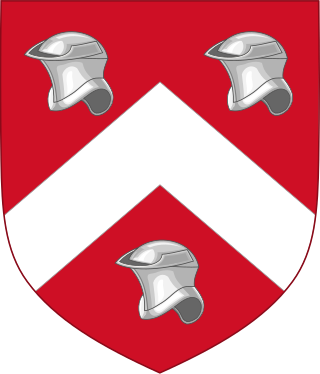See also
- Gwladus Ddu (died 1254), Welsh noblewoman, daughter of Llywelyn the Great of Gwynedd
- Gladys (disambiguation)
- Gladys (given name)
Saint Gwladys ferch Brychan or St Gladys (Latin-Claudia), was the beautiful Queen of Saint Gwynllyw Milwr.
Gwladys is also the name of:

Llywelyn ap Gruffudd, Llywelyn II, also known as Llywelyn the Last, was the native Prince of Wales from 1258 until his death at Cilmeri in 1282. Llywelyn was the son of Gruffydd ap Llywelyn Fawr and grandson of Llywelyn the Great, and he was one of the last native and independent princes of Wales before its conquest by Edward I of England and English rule in Wales that followed, until Owain Glyndŵr held the title during the Welsh Revolt of 1400–1415.

Owain ap Gruffudd was King of Gwynedd, North Wales, from 1137 until his death in 1170, succeeding his father Gruffudd ap Cynan. He was called Owain the Great and the first to be styled "Prince of Wales", and the "Prince of the Welsh". He is considered to be the most successful of all the North Welsh princes prior to his grandson, Llywelyn the Great. He became known as Owain Gwynedd to distinguish him from the contemporary king of Powys Wenwynwyn, Owain ap Gruffydd ap Maredudd, who became known as Owain Cyfeiliog.

Sir Owen Tudor was a Welsh courtier and the second husband of Queen Catherine of Valois (1401–1437), widow of King Henry V of England. He was the grandfather of Henry VII, founder of the Tudor dynasty.

Sir David Hanmer, KS, SL (c.1332–1387) was a fourteenth century Anglo-Welsh Justice of the King's Bench from Hanmer, Wales, best known as Owain Glyndŵr's father-in-law and the father of Glyndŵr's chief supporters.

Rhys ap Tewdwr was a king of Deheubarth in Wales and member of the Dinefwr dynasty, a branch descended from Rhodri the Great. Following the Norman Conquest, he had to pay William the Conqueror to keep his kingdom, which lasted until the end of William's reign.

Dafydd ap Llewelyn ap Hywel, better known as Dafydd Gam, anglicized to David or Davy Gam, was a Welsh warrior, a prominent opponent of Owain Glyndŵr. He died at the Battle of Agincourt fighting for Henry V, King of England in that victory against the French.

Sir William ap Thomas was a Welsh nobleman, politician, knight, and courtier. He was a member of the Welsh gentry family that came to be known as the Herbert family through his son William Herbert, 1st Earl of Pembroke and is the agnatic ancestor, via an illegitimate descendant of the 1st Earl of the 8th creation, of the current Herbert family of the Earl of Pembroke and Montgomery, and also of the Herbert Earl of Carnarvon.

William Herbert, 1st Earl of PembrokeKG, known as "Black William", was a Welsh nobleman, soldier, politician, and courtier.
Gwladys ferch Dafydd was the daughter of Dafydd ap Gruffydd, the last free Prince of Wales, and Elizabeth Ferrers. She probably spent most of her early life in the company of her father in England and Gwynedd.
Gwladus Ddu,, full name Gwladus ferch Llywelyn was a Welsh noblewoman who was a daughter of Llywelyn the Great of Gwynedd and Joan Plantagenet, a daughter of John, King of England. She married two Marcher lords.

Saint Gwladys ferch Brychan or St Gladys, daughter of King Brychan of Brycheiniog, was the queen of the saint-king Gwynllyw Milwr and the mother of Cadoc "the Wise", whose Vita may be the earliest saint's life to mention Arthur. Gwladys's other children were Cynidr, Bugi, Cyfyw, Maches, Glywys II and Egwine. Today her main church and associated school is in Bargoed.

Anwyl of Tywyn are a Welsh family who claim a patrilinear descent from Owain Gwynedd, King of Gwynedd from 1137 to 1170 and a scion of the royal House of Aberffraw. The family motto is: Eryr eryrod Eryri, which translates as "The Eagle of the Eagles of Snowdonia. The family lives in Gwynedd and speak Welsh.

Dafydd ap Gruffydd, was Prince of Wales from 11 December 1282 until his execution on 3 October 1283 on the orders of King Edward I of England. He was the last native Prince of Wales before the conquest of Wales by Edward I in 1283 and English rule in Wales that followed, until Owain Glyndŵr held the title during the Welsh Revolt of 1400–1415.
Ferch may refer to:

Gwladys ferch Dafydd Gam was a Welsh noblewoman. She was the daughter of Dafydd ap Llewelyn ap Hywel, otherwise known as Dafydd Gam, who was killed at the Battle of Agincourt in 1415.

Sir Roger Vaughan of Tretower Court, was the son of Welsh noblewoman Gwladys ferch Dafydd Gam and Sir Roger Vaughan of Bredwardine, who fought and died with Gwladys's father, Dafydd Gam in the Battle of Agincourt in 1415.

Sir Roger Vaughan of Bredwardine, also known as Roger Fychan or Roger the younger, was a Welsh gentleman, described as having possessed wealth, rank, and high respectability. Roger's seat, Bredwardine Castle, is estimated to have been a strong and formidable fortress, located on the banks of the Wye river in Herefordshire, two miles north of Moccas Court. Bredwardine Castle is thought to have furnished much of the material for the building of Moccas Court.
Roger Vaughan (1834–1883) was an English Benedictine monk of Downside Abbey and Roman Catholic Archbishop of Sydney, 1877–1883.
Anne Devereux, Countess of Pembroke, was an English noblewoman, who was Countess of Pembroke during the 15th century by virtue of marriage to William Herbert, 1st Earl of Pembroke.